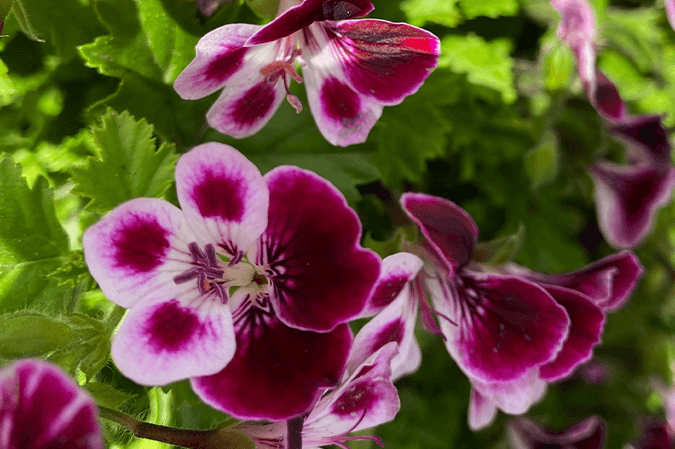Geranium is a genus of flowering plants that belongs to the family Geraniaceae. The name “Geranium” is derived from the Greek word “geranos,” meaning “crane,” due to the crane-like appearance of the seed pods. Geraniums are popular in gardens and landscaping for their attractive foliage, diverse flower colors, and ease of care. They are often confused with Pelargoniums, which are commonly referred to as “geraniums” in horticulture but belong to a different genus.
Description
- Appearance: Geraniums are herbaceous plants that can be annuals, biennials, or perennials. They are known for their symmetrical, five-petaled flowers, which can be found in shades of pink, purple, white, and blue. The flowers typically have a radial symmetry, with each petal often marked by distinct veining.
- Leaves: The leaves of Geraniums are typically palmate (hand-shaped) with several lobes, often serrated or scalloped at the edges. The foliage can be aromatic, releasing a pleasant scent when crushed.
- Growth Habit: Geraniums can vary in size from small, ground-covering species to taller, bushy plants. They generally have a sprawling or mounding growth habit, making them suitable for borders, containers, or ground covers.
- Distribution: Geraniums are native to temperate regions around the world, particularly in the Mediterranean, but they can be found in various climates, from tropical to alpine regions.
Common Features
- Flowers: Geranium flowers are typically small, about 1-2 inches in diameter, with five petals that may be slightly overlapping. The flowers can appear singly or in clusters, and they bloom throughout the growing season, often from spring to autumn.
- Stems: The stems of Geraniums are often hairy and can be green or reddish. They are usually soft and flexible, allowing the plant to spread or trail.
- Seed Pods: The seed pods of Geraniums are elongated and resemble the beak of a crane, hence the name. These pods split open when ripe, dispersing seeds.
Role in the Ecosystem
- Pollinator Support: Geraniums are important nectar sources for a variety of pollinators, including bees, butterflies, and hoverflies. Their flowers are designed to attract these insects, contributing to pollination in the ecosystem.
- Soil Health: Geraniums help improve soil health by preventing erosion with their dense root systems. Their decaying leaves also add organic matter to the soil, enriching it over time.
- Wildlife Habitat: The dense foliage of Geraniums provides shelter and habitat for various small insects and animals, contributing to local biodiversity.
Importance
- Ornamental Value: Geraniums are widely grown as ornamental plants in gardens, containers, and hanging baskets. Their long flowering season, coupled with their diverse colors and ease of care, makes them popular in landscaping.
- Medicinal Uses: Some species of Geranium have been used in traditional medicine for their astringent, anti-inflammatory, and antimicrobial properties. Geranium oil, extracted from the leaves, is used in aromatherapy and skin care for its soothing effects.
- Cultural Significance: In Victorian flower symbolism, Geraniums represented friendship and true affection. They are also associated with good health and cheerfulness in various cultures.
- Companion Planting: Geraniums are often used in companion planting due to their ability to repel certain pests, such as cabbage worms and leafhoppers. Their strong scent is believed to deter harmful insects, making them valuable in vegetable gardens.
Interesting Facts
- Hardy Geraniums vs. Pelargoniums: In horticulture, “geranium” often refers to Pelargoniums, which are not true Geraniums but share similar features. True Geraniums are also known as “cranesbills” and are generally more cold-hardy.
- Geranium Oil: Geranium oil, particularly from Pelargonium graveolens, is widely used in the perfume and cosmetics industry. It has a rose-like scent and is prized for its aromatic and therapeutic properties.
- Symbolism: Geraniums are often associated with positive emotions and are believed to bring protection and happiness. In some cultures, they are planted near windows to ward off evil spirits.
- Global Distribution: While native to temperate regions, Geraniums have been naturalized in many parts of the world, thriving in various climates from mountainous areas to coastal regions.
Sources
- Royal Horticultural Society – Geranium Plant Information
- “The Genus Geranium: A Horticultural Guide” by John Wood
- The American Horticultural Society Encyclopedia of Plants and Flowers – Geranium Section



